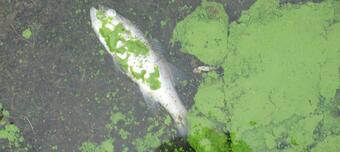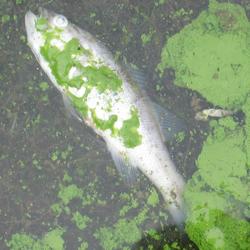You may notice a green, red or brown film on your favorite boating or swimming area in the summer. This coloring could mean that the water is affected by harmful algal blooms. USGS scientists Dr. Barry Rosen, Dr. Jennifer Graham and Dr.
New Study on Cyanotoxins in Lakes and Reservoirs Provides Insights into Assessing Health Risks Completed
Cyanobacterial Accumulation at Binder Lake, Iowa
Close Up of a Cyanobacteria Bloom on Elysian Lake, Minnesota
Occurrence of Microcystins in Lakes in the Contiguous US 48 states
Newly published study provides new evidence of the widespread occurrence of cyanotoxins in lakes and reservoirs of the United States and offers new insights into measures used for assessing potential recreational health risks.

In 2007, scientists completed the largest survey of cyanotoxins in the Nation's lakes. Scientists sampled 1,161 lakes across the Nation for cyanotoxins, cyanobacteria abundance, and chlorophyll-a—the three measures used by the World Health Organization (WHO) to determine associated human health risks in recreational waters ranging from skin rashes and nausea to liver failure and respiratory distress. The scientists measured several cyanotoxins including cylindrospermopsins, microcystins, and saxitoxins.
Although cyanotoxin occurrence in lakes was commonly perceived to have a local or regional occurrence, this study found multiple classes of cyanotoxins were present in lakes and reservoirs in diverse settings across the United States. Cyanobacteria were present in 98 percent of the lakes studied. Potential cylindrospermopsin-, microcystin-, and saxitoxin-producing cyanobacteria were present in 81, 67, 95, and 79 percent of samples, respectively; however, the toxins were present in 4.0, 32, and 7.7 percent, respectively, which indicated that cyanobacterial abundance can over-predict microcystin and other cyanotoxin exposure risk.

The WHO moderate and high risk thresholds for microcystins, cyanobacteria abundance, and total chlorophyll were exceeded in 1.1, 27, and 44 percent of samples, respectively. There was direct agreement between the three WHO measures used for recreational risk on the basis of microcystin exposure in only 27 percent of the samples measured in this study, which indicated that algal abundance and chlorophyll-a concentrations may over-predict recreational risks associated with cyanotoxins. The lack of similarity among the WHO thresholds was expected because chlorophyll is common amongst all algae and not all algae produce microcystins.
There is increasing public recognition that cyanobacteria and their toxins can have a toxic effect on water use and quality. Some cyanobacteria produce toxins that can kill wildlife and domestic animals and cause illness or death in humans through exposure to contaminated freshwater or by the consumption of contaminated drinking water, fish, or shellfish. The discovery, in 2014, that the City of Toledo, Ohio, water supply was contaminated by microcystins drew national attention to the potential vulnerabilities of our water resources to toxins formed in association with harmful algal blooms.

Typically, studies done for harmful algal bloom event response programs only measure microcystins or algal abundance and less frequently chlorophyll or other cyanotoxins, whereas ambient monitoring programs usually focus on chlorophyll and algal abundance measures to assess health risks. This study demonstrates that monitoring for chlorophyll is not a reliable indicator of the presence of microcystins; monitoring for microcystins is not a reliable indicator of the presence of saxitoxins and cylindrospermopsins; and that microcystins are not the only toxins for consideration of risk to humans and animals.
This study provides information needed to understand the relation between current (2016) measures of potential recreational health risks of cyanohabs and highlights the importance of selecting measurements that closely relate to monitoring objectives. This assessment was performed as part of a broader U.S. Geological Survey (USGS) research project on cyanotoxins. The broader research goals include determination of factors related to cyanotoxin production and factors that may influence or create new environmental pathways of cyanobacteria that lead to human and ecological exposure and adverse outcomes.
This research was funded by the USGS Ecosystems Mission Area’s Environmental Health Program (Contaminant Biology and Toxic Substances Hydrology) and National Water Quality Assessment Programs, and U.S. Environmental Protection Agency's Office of Wetlands, Oceans, and Watersheds and National Health and Environmental Effects Research.
Below are other science projects associated with this project.
Toxins and Harmful Algal Blooms Science Team
USGS Scientist Receives Award for Assistance with National Wetlands Assessment
Nitrate Addition Enhances Arsenic Immobilization in Groundwater
New Study Measures Crop Bactericide, Nitrapyrin, in Iowa Streams
Nutrients in Dust from the Sahara Desert cause Microbial Blooms on the East Coast of the United States
USGS Scientists Measure New Bacterial Nitrogen Removal Process in Groundwater
Cyanobacterial (Blue-Green Algal) Blooms: Tastes, Odors, and Toxins
Importance of Lake Sediments in Removal of Cyanobacteria, Viruses, and Dissolved Organic Carbon
U.S. Geological Survey Scientists Complete First Systematic Regional Survey of Algal Toxins in Streams of the Southeastern United States
Remote Sensing Provides a National View of Cyanobacteria Blooms
Algal Blooms Consistently Produce Complex Mixtures of Cyanotoxins and Co-Occur with Taste-and-Odor Causing Compounds in 23 Midwestern Lakes
Below are multimedia items associated with this project.
You may notice a green, red or brown film on your favorite boating or swimming area in the summer. This coloring could mean that the water is affected by harmful algal blooms. USGS scientists Dr. Barry Rosen, Dr. Jennifer Graham and Dr.
Below are publications associated with this project.
Cyanobacterial harmful algal blooms and U.S. Geological Survey science capabilities
Cyanotoxins in inland lakes of the United States: Occurrence and potential recreational health risks in the EPA National Lakes Assessment 2007
Total cylindrospermopsins, microcystins/nodularins, and saxitoxins data for the 2007 United States Environmental Protection Agency National Lake Assessment
Field and laboratory guide to freshwater cyanobacteria harmful algal blooms for Native American and Alaska Native communities
Microphotographs of cyanobacteria documenting the effects of various cell-lysis techniques
Harmful algal blooms
Below are news stories associated with this project.
Newly published study provides new evidence of the widespread occurrence of cyanotoxins in lakes and reservoirs of the United States and offers new insights into measures used for assessing potential recreational health risks.

In 2007, scientists completed the largest survey of cyanotoxins in the Nation's lakes. Scientists sampled 1,161 lakes across the Nation for cyanotoxins, cyanobacteria abundance, and chlorophyll-a—the three measures used by the World Health Organization (WHO) to determine associated human health risks in recreational waters ranging from skin rashes and nausea to liver failure and respiratory distress. The scientists measured several cyanotoxins including cylindrospermopsins, microcystins, and saxitoxins.
Although cyanotoxin occurrence in lakes was commonly perceived to have a local or regional occurrence, this study found multiple classes of cyanotoxins were present in lakes and reservoirs in diverse settings across the United States. Cyanobacteria were present in 98 percent of the lakes studied. Potential cylindrospermopsin-, microcystin-, and saxitoxin-producing cyanobacteria were present in 81, 67, 95, and 79 percent of samples, respectively; however, the toxins were present in 4.0, 32, and 7.7 percent, respectively, which indicated that cyanobacterial abundance can over-predict microcystin and other cyanotoxin exposure risk.

The WHO moderate and high risk thresholds for microcystins, cyanobacteria abundance, and total chlorophyll were exceeded in 1.1, 27, and 44 percent of samples, respectively. There was direct agreement between the three WHO measures used for recreational risk on the basis of microcystin exposure in only 27 percent of the samples measured in this study, which indicated that algal abundance and chlorophyll-a concentrations may over-predict recreational risks associated with cyanotoxins. The lack of similarity among the WHO thresholds was expected because chlorophyll is common amongst all algae and not all algae produce microcystins.
There is increasing public recognition that cyanobacteria and their toxins can have a toxic effect on water use and quality. Some cyanobacteria produce toxins that can kill wildlife and domestic animals and cause illness or death in humans through exposure to contaminated freshwater or by the consumption of contaminated drinking water, fish, or shellfish. The discovery, in 2014, that the City of Toledo, Ohio, water supply was contaminated by microcystins drew national attention to the potential vulnerabilities of our water resources to toxins formed in association with harmful algal blooms.

Typically, studies done for harmful algal bloom event response programs only measure microcystins or algal abundance and less frequently chlorophyll or other cyanotoxins, whereas ambient monitoring programs usually focus on chlorophyll and algal abundance measures to assess health risks. This study demonstrates that monitoring for chlorophyll is not a reliable indicator of the presence of microcystins; monitoring for microcystins is not a reliable indicator of the presence of saxitoxins and cylindrospermopsins; and that microcystins are not the only toxins for consideration of risk to humans and animals.
This study provides information needed to understand the relation between current (2016) measures of potential recreational health risks of cyanohabs and highlights the importance of selecting measurements that closely relate to monitoring objectives. This assessment was performed as part of a broader U.S. Geological Survey (USGS) research project on cyanotoxins. The broader research goals include determination of factors related to cyanotoxin production and factors that may influence or create new environmental pathways of cyanobacteria that lead to human and ecological exposure and adverse outcomes.
This research was funded by the USGS Ecosystems Mission Area’s Environmental Health Program (Contaminant Biology and Toxic Substances Hydrology) and National Water Quality Assessment Programs, and U.S. Environmental Protection Agency's Office of Wetlands, Oceans, and Watersheds and National Health and Environmental Effects Research.
Below are other science projects associated with this project.
Toxins and Harmful Algal Blooms Science Team
USGS Scientist Receives Award for Assistance with National Wetlands Assessment
Nitrate Addition Enhances Arsenic Immobilization in Groundwater
New Study Measures Crop Bactericide, Nitrapyrin, in Iowa Streams
Nutrients in Dust from the Sahara Desert cause Microbial Blooms on the East Coast of the United States
USGS Scientists Measure New Bacterial Nitrogen Removal Process in Groundwater
Cyanobacterial (Blue-Green Algal) Blooms: Tastes, Odors, and Toxins
Importance of Lake Sediments in Removal of Cyanobacteria, Viruses, and Dissolved Organic Carbon
U.S. Geological Survey Scientists Complete First Systematic Regional Survey of Algal Toxins in Streams of the Southeastern United States
Remote Sensing Provides a National View of Cyanobacteria Blooms
Algal Blooms Consistently Produce Complex Mixtures of Cyanotoxins and Co-Occur with Taste-and-Odor Causing Compounds in 23 Midwestern Lakes
Below are multimedia items associated with this project.
You may notice a green, red or brown film on your favorite boating or swimming area in the summer. This coloring could mean that the water is affected by harmful algal blooms. USGS scientists Dr. Barry Rosen, Dr. Jennifer Graham and Dr.
You may notice a green, red or brown film on your favorite boating or swimming area in the summer. This coloring could mean that the water is affected by harmful algal blooms. USGS scientists Dr. Barry Rosen, Dr. Jennifer Graham and Dr.
Below are publications associated with this project.
Cyanobacterial harmful algal blooms and U.S. Geological Survey science capabilities
Cyanotoxins in inland lakes of the United States: Occurrence and potential recreational health risks in the EPA National Lakes Assessment 2007
Total cylindrospermopsins, microcystins/nodularins, and saxitoxins data for the 2007 United States Environmental Protection Agency National Lake Assessment
Field and laboratory guide to freshwater cyanobacteria harmful algal blooms for Native American and Alaska Native communities
Microphotographs of cyanobacteria documenting the effects of various cell-lysis techniques
Harmful algal blooms
Below are news stories associated with this project.












